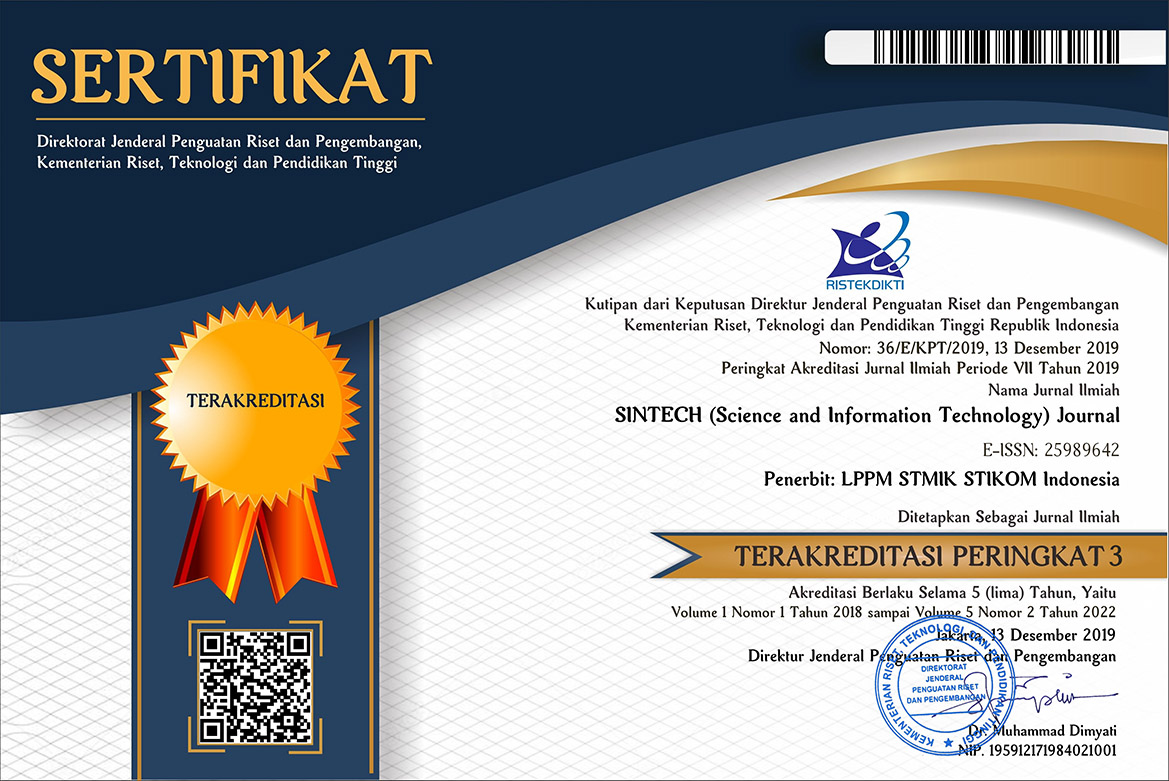Klasifikasi Penyakit Infeksi Pada Ayam Berdasarkan Gambar Feses Menggunakan Convolutional Neural Network
DOI:
https://doi.org/10.31598/sintechjournal.v5i2.1179Keywords:
Artifical Intelligence, Deep Learning, Keras/TensorFlow, Infectious Disease, Feces ImagesAbstract
Convolutional Neural Network (CNN) is one of the Deep Learning methods that is able to carry out an independent learning process that is popular and appropriate in classifying. The development of technology in the field of Deep Learning, this study aims to assist farmers in identifying the types of infectious diseases that attack chickens based on faecal images using Convolutional Neural Network (CNN) so as to increase production yields. Several infectious diseases that attack chickens can be identified through their feces, including newcastle disease caused by a virus, pullorum caused by bacteria, and coccidiosis caused by parasites. To identify, it is necessary to classify the types of diseases that attack by using images of chicken feces. With deep learning using Keras/TensorFlow, 95.40% of chicken feces images are predicted to be infected with coccidiosis, 94.97% chicken feces images are predicted to be healthy, 90.21% chicken feces images are predicted to be infected with tetelo disease, and 96.50% chicken feces images are predicted to be infected with pullorum disease
Downloads
References
Samuel, Arthur L. "Some Studies in Machine Learning Using the Game of Checkers," IBM Journal of Research and Development 44:1.2 (1959): 210-229.
Walsh, Joseph & O' Mahony, Niall & Campbell, Sean & Carvalho, Anderson & Krpalkova, Lenka & Velasco-Hernandez, Gustavo & Harapanahalli, Suman & Riordan, Daniel. (2019). Deep Learning vs. Traditional Computer Vision. 10.1007/978-3-030-17795-9_10.
Ahmed, Ghufran & Malick, Rauf & Akhunzada, Adnan & Zahid, Sumaiyah & Sagri, Muhammad & Gani, Abdullah. (2021). An Approach towards IoT-Based Predictive Service for Early Detection of Diseases in Poultry Chickens. Sustainability. 13. 13396. 10.3390/su132313396.
Pudjiatmoko, dkk. 2014. Manual Penyakit Unggas. Kementerian Pertanian.
Mbelwa, Hope & Mbelwa, Jimmy & Machuve, Dina. (2021). Deep Convolutional Neural Network for Chicken Diseases Detection. International Journal of Advanced Computer Science and Applications. 12. 10.14569/IJACSA.2021.0120295.
https://www.kaggle.com/datasets/allandclive/chicken-disease-1 (access January 18, 2022).
R. Ashraf, M. Habib, M. Akram, M. Latif, M. Malik, M. Awais, S. Dar, T. Mahmood, M. Yasir, and Z. Abbas, “Deep convolution neural network for big data medical image classification,” IEEE Access, vol. PP, pp. 1–1, 06 2020.
McLeod, R., & Schell, G. P. (2007). Management Information Systems. USA: Pearson/Prentice Hall.McLeod, R., & Schell, G. P. (2007). Management Information Systems. USA: Pearson/Prentice Hall.
Aurelien Geron. (2017). Hands-On Machine Learning with Scikit-Learn & Tensorflow. O'Reilly.
W.M. Campbell, Using Deep Belief Networks for Vector-Based Speaker Recognition, in Interspeech, 2014, p 676.
Sebastian Raschka, , Vahid Mirjalili. (2019). Python Machine Learning: Machine Learning and Deep Learning with Python, scikit-learn, and TensorFlow 2, 3rd Edition. Packt Publishing.
Wang, Xinggang & Yang, Wei & Weinreb, Jeffrey & Han, Juan & Li, Qiubai & Kong, Xiangchuang & Yan, Yongluan & Ke, Zan & Luo, Bo & Liu, Tao & Wang, Liang. (2017). Searching for prostate cancer by fully automated magnetic resonance imaging classification: Deep learning versus non-deep learning. Scientific Reports. 7. 10.1038/s41598-017-15720-y.
J. Guo, "Research on Artificial Intelligence: Deep Learning to Identify Plant Species," 2022 International Conference on Machine Learning and Knowledge Engineering (MLKE), 2022, pp. 59-66, doi: 10.1109/MLKE55170.2022.00017.
Matthew Moocarme, Anthony So, Anthony Maddalone. (2021). The TensorFlow Workshop: A hands-on guide to building deep learning models from scratch using real-world datasets. Packt Publishing.
Jing, Yang & Guanci, Yang. (2018). Modified Convolutional Neural Network Based on Dropout and the Stochastic Gradient Descent Optimizer. Algorithms. 11. 28. 10.3390/a11030028.
Jmour, Nadia & Zayen, Sehla & Abdelkrim, Afef. (2018). Convolutional neural networks for image classification. 397-402. 10.1109/ASET.2018.8379889.
Pedregosa, Fabian & Varoquaux, Gael & Gramfort, Alexandre & Michel, Vincent & Thirion, Bertrand & Grisel, O. & Blondel, M. & Prettenhofer, P. & Weiss, R. & Dubourg, Vincent & Vanderplas, I. & Passos, A. & Cournapeau, D. & Brucher, Matthieu & Perrot, Matthieu & Duchesnay, Edouard. (2011). Scikit-Iearn: Machine learning in python. Journal of Machine Learning Research. 12.
Shlezinger, Nir & Eldar, Yonina & Boyd, Stephen. (2022). Model-Based Deep Learning: On the Intersection of Deep Learning and Optimization.
Singh, Rajesh & Gehlot, Anita & Prajapat, Mahesh & Singh, Bhupendra. (2021). Deep Learning. 10.1201/9781003245759-5.
Y. -n. Dong and G. -s. Liang, "Research and Discussion on Image Recognition and Classification Algorithm Based on Deep Learning," 2019 International Conference on Machine Learning, Big Data and Business Intelligence (MLBDBI), 2019, pp. 274-278, doi: 10.1109/MLBDBI48998.2019.000.
Downloads
Published
How to Cite
Issue
Section
License
Copyright (c) 2022 Moch. Kholil, Heri Priya Waspada , Rafika Akhsani

This work is licensed under a Creative Commons Attribution-NonCommercial-ShareAlike 4.0 International License.
Copyright in each article belongs to the author.
- The authors admit that SINTECH Journal as a publisher who published the first time under
 Attribution-NonCommercial-ShareAlike 4.0 International (CC BY-NC-SA 4.0) License.
Attribution-NonCommercial-ShareAlike 4.0 International (CC BY-NC-SA 4.0) License. - Authors can include writing separately, regulate distribution of non-ekskulif of manuscripts that have been published in this journal into another version (eg sent to respository institution author, publication into a book, etc.), by recognizing that the manuscripts have been published for the first time in SINTECH Journal















1.png)




